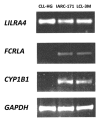Lymphoblastoid cell line with B1 cell characteristics established from a chronic lymphocytic leukemia clone by in vitro EBV infection
- PMID: 22720208
- PMCID: PMC3376971
- DOI: 10.4161/onci.1.1.18400
Lymphoblastoid cell line with B1 cell characteristics established from a chronic lymphocytic leukemia clone by in vitro EBV infection
Abstract
Chronic lymphocytic leukemia (CLL) cells express the receptor for Epstein-Barr virus (EBV) and can be infected in vitro. Infected cells do not express the growth-promoting set of EBV-encoded genes and therefore they do not yield LCLs, in most experiments. With exceptional clones, lines were obtained however. We describe a new line, HG3, established by in vitro EBV-infection from an IGHV1-2 unmutated CLL patient clone. All cells expressed EBNA-2 and LMP-1, the EBV-encoded genes pivotal for transformation. The karyotype, FISH cytogenetics and SNP-array profile of the line and the patient's ex vivo clone showed biallelic 13q14 deletions with genomic loss of DLEU7, miR15a/miR16-1, the two micro-RNAs that are deleted in 50% of CLL cases. Further features of CLL cells were: expression of CD5/CD20/CD27/CD43 and release of IgM natural antibodies reacting with oxLDL-like epitopes on apoptotic cells (cf. stereotyped subset-1). Comparison with two LCLs established from normal B cells showed 32 genes expressed at higher levels (> 2-fold). Among these were LHX2 and LILRA. These genes may play a role in the development of the disease. LHX2 expression was shown in self-renewing multipotent hematopoietic stem cells, and LILRA4 codes for a receptor for bone marrow stromal cell antigen-2 that contributes to B cell development. Twenty-four genes were expressed at lower levels, among these PARD3 that is essential for asymmetric cell division. These genes may contribute to establish precursors of CLL clones by regulation of cellular phenotype in the hematopoietic compartment. Expression of CD5/CD20/CD27/CD43 and spontaneous production of natural antibodies may identify the CLL cell as a self-renewing B1 lymphocyte.
Figures






Similar articles
-
Cytokines and Epstein Barr virus (EBV) genes expression in blood chronic lymphocytic leukaemia (CLL) cells and their immortalised CLL cell lines.Anticancer Res. 2003 Sep-Oct;23(5A):4017-22. Anticancer Res. 2003. PMID: 14666712
-
Epstein-Barr virus (EBV) can immortalize B-cll cells activated by cytokines.Leukemia. 1994 Mar;8(3):476-84. Leukemia. 1994. PMID: 8127151
-
Infection of leukaemic B lymphocytes by Epstein Barr virus.Leukemia. 1993 Nov;7(11):1858-64. Leukemia. 1993. PMID: 8231253
-
Restricted expression of EBV encoded proteins in in vitro infected CLL cells.Semin Cancer Biol. 2010 Dec;20(6):410-5. doi: 10.1016/j.semcancer.2010.10.013. Epub 2010 Oct 27. Semin Cancer Biol. 2010. PMID: 21034831 Review.
-
Human B-lymphoid cell lines.Hum Cell. 1992 Mar;5(1):25-41. Hum Cell. 1992. PMID: 1329931 Review.
Cited by
-
Global distribution of DNA hydroxymethylation and DNA methylation in chronic lymphocytic leukemia.Epigenetics Chromatin. 2019 Jan 7;12(1):4. doi: 10.1186/s13072-018-0252-7. Epigenetics Chromatin. 2019. PMID: 30616658 Free PMC article.
-
Mcl-1 and Bcl-xL levels predict responsiveness to dual MEK/Bcl-2 inhibition in B-cell malignancies.Mol Oncol. 2022 Mar;16(5):1153-1170. doi: 10.1002/1878-0261.13153. Epub 2021 Dec 18. Mol Oncol. 2022. PMID: 34861096 Free PMC article.
-
Identification of context-dependent expression quantitative trait loci in whole blood.Nat Genet. 2017 Jan;49(1):139-145. doi: 10.1038/ng.3737. Epub 2016 Dec 5. Nat Genet. 2017. PMID: 27918533
-
The unfolded protein response influences therapy outcome and disease progression in chronic lymphocytic leukaemia.Sci Rep. 2025 Jul 28;15(1):27496. doi: 10.1038/s41598-025-13495-1. Sci Rep. 2025. PMID: 40721481 Free PMC article.
-
Enhancer-driven gene regulatory networks inference from single-cell RNA-seq and ATAC-seq data.Brief Bioinform. 2024 Jul 25;25(5):bbae369. doi: 10.1093/bib/bbae369. Brief Bioinform. 2024. PMID: 39082647 Free PMC article.
References
Publication types
LinkOut - more resources
Full Text Sources
Other Literature Sources
Research Materials
